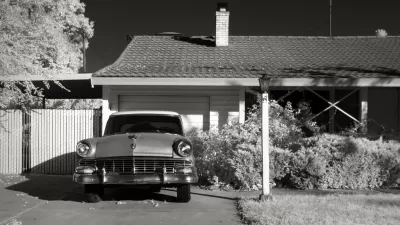The nation has a huge quantity of postwar housing that can be made more walkable and appealing to new generations of residents. Robert Steuteville examines what makes them good candidates and notes some examples of successful retrofits.

"World War II has long been considered the watershed for automobile-oriented development. Suburbs were built prior to the war, but largely were mixed-use, walkable towns and neighborhoods of the 'streetcar suburb' variety."
"After 1945, development shifted radically — to automobile-oriented housing with various types of single-use commercial development along arterial highways."
"Yet this binary view — traditional neighborhoods before the war; suburban sprawl afterward — obscures differences in postwar suburban patterns that can exert a critical impact on revitalization. Planners and theorists have in recent years been debating how to fix the suburbs, as discussed in books such as Retrofitting Suburbia by Ellen Dunham-Jones and June Williamson, and Sprawl Repair Manual by Galina Tachieva. This year, Arthur C. Nelson in Reshaping Metropolitan America made the demographic case that redevelopment of low-density commercial buildings – largely in the suburbs — could meet all of the US new housing needs in the coming decades."
"As successful case studies pile up, demonstrating the high returns generated by redevelopment associated with Leave it to Beaver neighborhoods," concludes Steuteville, "more public funds could be allocated into remaking the 'corridors of crap' into main streets. This, in turn, could generate momentum for bringing new life to the suburbs built after World War II and make US metropolitan regions more sustainable, appealing, and economically viable."
FULL STORY: Postwar neighborhoods are key to suburban revitalization

Planetizen Federal Action Tracker
A weekly monitor of how Trump’s orders and actions are impacting planners and planning in America.

Maui's Vacation Rental Debate Turns Ugly
Verbal attacks, misinformation campaigns and fistfights plague a high-stakes debate to convert thousands of vacation rentals into long-term housing.

San Francisco Suspends Traffic Calming Amidst Record Deaths
Citing “a challenging fiscal landscape,” the city will cease the program on the heels of 42 traffic deaths, including 24 pedestrians.

Defunct Pittsburgh Power Plant to Become Residential Tower
A decommissioned steam heat plant will be redeveloped into almost 100 affordable housing units.

Trump Prompts Restructuring of Transportation Research Board in “Unprecedented Overreach”
The TRB has eliminated more than half of its committees including those focused on climate, equity, and cities.

Amtrak Rolls Out New Orleans to Alabama “Mardi Gras” Train
The new service will operate morning and evening departures between Mobile and New Orleans.
Urban Design for Planners 1: Software Tools
This six-course series explores essential urban design concepts using open source software and equips planners with the tools they need to participate fully in the urban design process.
Planning for Universal Design
Learn the tools for implementing Universal Design in planning regulations.
Heyer Gruel & Associates PA
JM Goldson LLC
Custer County Colorado
City of Camden Redevelopment Agency
City of Astoria
Transportation Research & Education Center (TREC) at Portland State University
Jefferson Parish Government
Camden Redevelopment Agency
City of Claremont


























